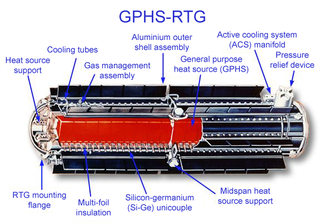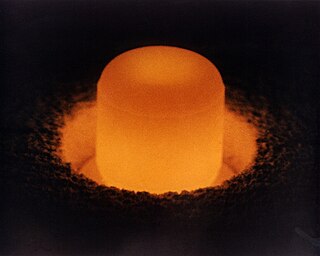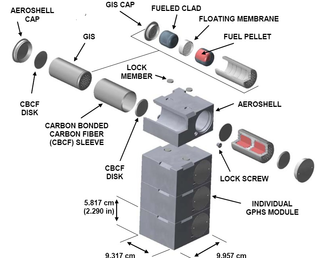A nuclear electric rocket is a type of spacecraft propulsion system where thermal energy from a nuclear reactor is converted to electrical energy, which is used to drive an ion thruster or other electrical spacecraft propulsion technology. The nuclear electric rocket terminology is slightly inconsistent, as technically the "rocket" part of the propulsion system is non-nuclear and could also be driven by solar panels. This is in contrast with a nuclear thermal rocket, which directly uses reactor heat to add energy to a working fluid, which is then expelled out of a rocket nozzle.

A radioisotope thermoelectric generator, sometimes referred to as a radioisotope power system (RPS), is a type of nuclear battery that uses an array of thermocouples to convert the heat released by the decay of a suitable radioactive material into electricity by the Seebeck effect. This type of generator has no moving parts and is ideal for deployment in remote and harsh environments for extended periods with no risk of parts wearing out or malfunctioning.

Thermoelectric cooling uses the Peltier effect to create a heat flux at the junction of two different types of materials. A Peltier cooler, heater, or thermoelectric heat pump is a solid-state active heat pump which transfers heat from one side of the device to the other, with consumption of electrical energy, depending on the direction of the current. Such an instrument is also called a Peltier device, Peltier heat pump, solid state refrigerator, or thermoelectric cooler (TEC) and occasionally a thermoelectric battery. It can be used either for heating or for cooling, although in practice the main application is cooling. It can also be used as a temperature controller that either heats or cools.

Thermoelectric materials show the thermoelectric effect in a strong or convenient form.
SiGe, or silicon–germanium, is an alloy with any molar ratio of silicon and germanium, i.e. with a molecular formula of the form Si1−xGex. It is commonly used as a semiconductor material in integrated circuits (ICs) for heterojunction bipolar transistors or as a strain-inducing layer for CMOS transistors. IBM introduced the technology into mainstream manufacturing in 1989. This relatively new technology offers opportunities in mixed-signal circuit and analog circuit IC design and manufacture. SiGe is also used as a thermoelectric material for high-temperature applications (>700 K).
A radioisotope rocket or radioisotope thermal rocket is a type of thermal rocket engine that uses the heat generated by the decay of radioactive elements to heat a working fluid, which is then exhausted through a rocket nozzle to produce thrust. They are similar in nature to nuclear thermal rockets such as NERVA, but are considerably simpler and often have no moving parts. Alternatively, radioisotopes may be used in a radioisotope electric rocket, in which energy from nuclear decay is used to generate the electricity used to power an electric propulsion system.

A radioisotope heater unit (RHU) is a small device that provides heat through radioactive decay. They are similar to tiny radioisotope thermoelectric generators (RTG) and normally provide about one watt of heat each, derived from the decay of a few grams of plutonium-238—although other radioactive isotopes could be used. The heat produced by these RHUs is given off continuously for several decades and, theoretically, for up to a century or more.
An atomic battery, nuclear battery, radioisotope battery or radioisotope generator is a device which uses energy from the decay of a radioactive isotope to generate electricity. Like nuclear reactors, they generate electricity from nuclear energy, but differ in that they do not use a chain reaction. Although commonly called batteries, they are technically not electrochemical and cannot be charged or recharged. They are very costly, but have an extremely long life and high energy density, and so they are typically used as power sources for equipment that must operate unattended for long periods of time, such as spacecraft, pacemakers, underwater systems and automated scientific stations in remote parts of the world.
Thermophotovoltaic (TPV) energy conversion is a direct conversion process from heat to electricity via photons. A basic thermophotovoltaic system consists of a hot object emitting thermal radiation and a photovoltaic cell similar to a solar cell but tuned to the spectrum being admitted[sic] from the hot object.

Plutonium-238 is a radioactive isotope of plutonium that has a half-life of 87.7 years.

A Stirling radioisotope generator (SRG) is a type of radioisotope generator based on a Stirling engine powered by a large radioisotope heater unit. The hot end of the Stirling converter reaches high temperature and heated helium drives the piston, with heat being rejected at the cold end of the engine. A generator or alternator converts the motion into electricity. Given the very constrained supply of plutonium, the Stirling converter is notable for producing about four times as much electric power from the plutonium fuel as compared to a radioisotope thermoelectric generator (RTG).
The Systems Nuclear Auxiliary POWER (SNAP) program was a program of experimental radioisotope thermoelectric generators (RTGs) and space nuclear reactors flown during the 1960s by NASA.

A thermoelectric generator (TEG), also called a Seebeck generator, is a solid state device that converts heat directly into electrical energy through a phenomenon called the Seebeck effect. Thermoelectric generators function like heat engines, but are less bulky and have no moving parts. However, TEGs are typically more expensive and less efficient.

The advanced Stirling radioisotope generator (ASRG) is a radioisotope power system first developed at NASA's Glenn Research Center. It uses a Stirling power conversion technology to convert radioactive-decay heat into electricity for use on spacecraft. The energy conversion process used by an ASRG is significantly more efficient than previous radioisotope systems, using one quarter of the plutonium-238 to produce the same amount of power.

The general-purpose heat source is a U.S. DOE-designed radioactive heat source for radioisotope thermoelectric generators (RTG) or Stirling radioisotope generators (SRG). It is meant for space applications and is packaged as a stackable module.

GPHS-RTG or general-purpose heat source — radioisotope thermoelectric generator, is a specific design of the radioisotope thermoelectric generator (RTG) used on US space missions. The GPHS-RTG was used on Ulysses (1), Galileo (2), Cassini-Huygens (3), and New Horizons (1).

The multi-mission radioisotope thermoelectric generator (MMRTG) is a type of radioisotope thermoelectric generator (RTG) developed for NASA space missions such as the Mars Science Laboratory (MSL), under the jurisdiction of the United States Department of Energy's Office of Space and Defense Power Systems within the Office of Nuclear Energy. The MMRTG was developed by an industry team of Aerojet Rocketdyne and Teledyne Energy Systems.

Nuclear power in space is the use of nuclear power in outer space, typically either small fission systems or radioactive decay for electricity or heat. Another use is for scientific observation, as in a Mössbauer spectrometer. The most common type is a radioisotope thermoelectric generator, which has been used on many space probes and on crewed lunar missions. Small fission reactors for Earth observation satellites, such as the TOPAZ nuclear reactor, have also been flown. A radioisotope heater unit is powered by radioactive decay and can keep components from becoming too cold to function, potentially over a span of decades.

The Multihundred-Watt radioisotope thermoelectric generator is a type of US radioisotope thermoelectric generator (RTG) developed for the Voyager spacecraft, Voyager 1 and Voyager 2.
Benjamin Abeles was an Austrian-Czech physicist whose research in the 1960s in the US on germanium–silicon alloys led to the technology used to power space probes such as the Voyager spacecraft. He grew up in Austria and Czechoslovakia and arrived in the UK in 1939 on one of the Kindertransport missions. He completed his education after the war in Czechoslovakia and Israel, obtaining a doctorate in physics. He then lived and worked as a research physicist in the US and retired in 1995. His honours include the 1979 Stuart Ballantine Medal and his induction into the New Jersey Inventors Hall of Fame (1991).













